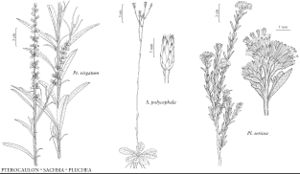Pterocaulon
Sketch Bot. S. Carolina 2: 323. 1823.
| Taxon | Illustrator ⠉ | |
|---|---|---|
 | Pterocaulon virgatum Sachsia polycephala Pluchea sericea | Barbara Alongi Barbara Alongi Barbara Alongi |
Perennials, 20–150 cm; usually rhizomatous and/or lignescent-tuberous-rooted. Stems erect, simple, internodes winged (by decurrent leaf-bases), lanate-tomentose and/or glandular. Leaves cauline, alternate; sessile; blades linear to elliptic or obovate, bases decurrent, margins usually serrate to serrulate or denticulate, rarely entire, abaxial faces densely whitish-tomentose [puberulent or glabrescent], adaxial (green) glabrous or glabrescent, both faces usually stipitate or sessile-glandular. Heads disciform, (sessile) in spiciform arrays (at ends of branches). Involucres cylindro-campanulate to campanulate, 2–3 [–5] mm diam. Phyllaries persistent, in 4–6 series, distinct, narrowly lanceolate, unequal (subindurate to scarious). Receptacles flat, epaleate. Ray-florets 0. Peripheral (pistillate) florets in 1–3+ series, fertile; corollas yellowish. Inner (functionally staminate [bisexual]) florets [1–] 2–15 [+]; corollas yellowish, lobes 5. Cypselae cylindric to fusiform, angled or slightly compressed, ribs 6–9 (white, narrow), faces usually sparsely strigose to hispidulous, minutely sessile-glandular between ribs; pappi persistent, of distinct, barbellulate bristles in 1–2 series. x = 10.
Distribution
North America, South America, Australasia
Discussion
Species 17 (2 in the flora).
The 11 primarily South American species of Pterocaulon sect. Pterocaulon have 1–17 functionally staminate florets per head, 1–2-seriate pappi, and hairs of tomentum with the relatively long, aseptate portion arising from clusters of basal cells. The 6 Australasian species of sect. Monenteles (Labillardière) Cabrera have a single functionally staminate floret per head, uniseriate pappi, and hairs of the tomentum equally septate throughout.
Selected References
Lower Taxa
Key
| 1 | Heads in dense, usually continuous, rarely interrupted, narrow, ± ovoid arrays (2–)3–8(–10) cm (axes completely hidden by crowded heads); lengths of leaf blades mostly 2–7 times widths; functionally staminate florets 6–10(–15); flowering May–Jun; Alabama, Florida, Georgia, Mississippi, North Carolina, South Carolina | Pterocaulon pycnostachyum |
| 1 | Heads in open, ± interrupted, ± cylindric arrays (5–)8–20 cm (main axes visible between glomerules of heads); lengths of leaf blades mostly 6–8 times widths; functionally staminate florets 2–4(–5); flowering Aug–Oct; Louisiana, Texas | Pterocaulon virgatum |